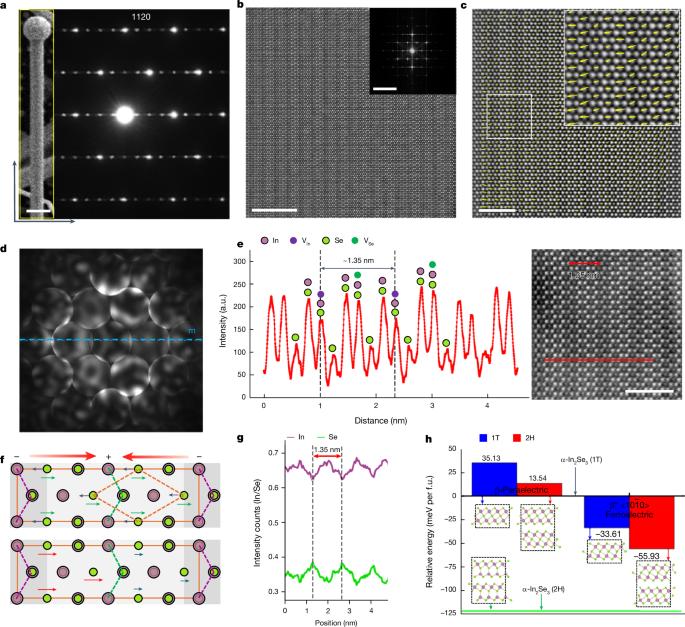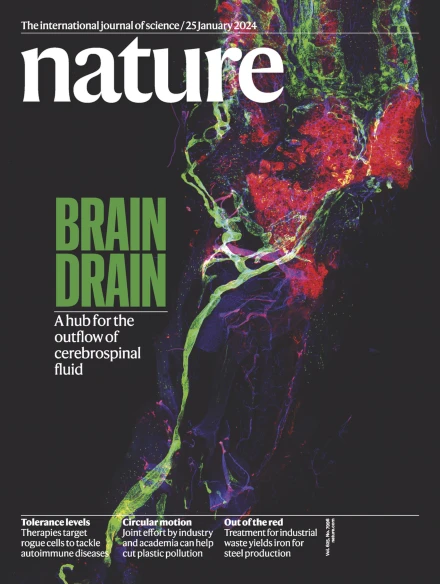铁性 In2Se3 中的电驱动长程固态非晶化现象
IF 50.5
1区 综合性期刊
Q1 MULTIDISCIPLINARY SCIENCES
引用次数: 0
摘要
电诱导非晶化并不常见,迄今为止只有少数几种材料系统通过脉冲电流实现了非晶化,这些系统大多基于熔融-淬火过程1。然而,如果能避免熔化步骤,并通过电能实现固态非晶化,就为低功耗器件应用提供了可能2,3,4,5。在这里,我们报告了通过应用直流偏压而不是脉冲电刺激,在硒化铟纳米线的新铁性β″相中实现的高能效、非传统的长程固态非晶化。垂直于极化的外加电场、平行于范德瓦耳斯层的电流和压电应力的复杂相互作用,导致层间滑动缺陷的形成,以及这种层状材料面内极化旋转引起的耦合无序。当达到电致无序的临界极限时,结构会变得受挫并局部坍缩为无定形相6,这种现象会通过声波抽搐在更大的微观长度尺度上复制7,8。我们的研究揭示了材料中的铁氧体阶序与外部施加的电场、电流和内部产生的应力之间以前未知的多模式耦合机制,有助于设计用于低功耗电子和光子应用的新材料和器件。本文章由计算机程序翻译,如有差异,请以英文原文为准。


Electrically driven long-range solid-state amorphization in ferroic In2Se3
Electrically induced amorphization is uncommon and has so far been realized by pulsed electrical current in only a few material systems, which are mostly based on the melt–quench process1. However, if the melting step can be avoided and solid-state amorphization can be realized electrically, it opens up the possibility for low-power device applications2–5. Here we report an energy-efficient, unconventional long-range solid-state amorphization in a new ferroic β″-phase of indium selenide nanowires through the application of a direct-current bias rather than a pulsed electrical stimulus. The complex interplay of the applied electric field perpendicular to the polarization, current flow parallel to the van der Waals layer and piezoelectric stress results in the formation of interlayer sliding defects and coupled disorder induced by in-plane polarization rotation in this layered material. On reaching a critical limit of the electrically induced disorder, the structure becomes frustrated and locally collapses into an amorphous phase6, and this phenomenon is replicated over a much larger microscopic-length scale through acoustic jerks7,8. Our work uncovers previously unknown multimodal coupling mechanisms of the ferroic order in materials to the externally applied electric field, current and internally generated stress, and can be useful to design new materials and devices for low-power electronic and photonic applications. Energy-efficient, solid-state amorphization of indium selenide nanowires is achieved using direct current, avoiding the melt–quench process.
求助全文
通过发布文献求助,成功后即可免费获取论文全文。
去求助
来源期刊

Nature
综合性期刊-综合性期刊
CiteScore
90.00
自引率
1.20%
发文量
3652
审稿时长
3 months
期刊介绍:
Nature is a prestigious international journal that publishes peer-reviewed research in various scientific and technological fields. The selection of articles is based on criteria such as originality, importance, interdisciplinary relevance, timeliness, accessibility, elegance, and surprising conclusions. In addition to showcasing significant scientific advances, Nature delivers rapid, authoritative, insightful news, and interpretation of current and upcoming trends impacting science, scientists, and the broader public. The journal serves a dual purpose: firstly, to promptly share noteworthy scientific advances and foster discussions among scientists, and secondly, to ensure the swift dissemination of scientific results globally, emphasizing their significance for knowledge, culture, and daily life.
 求助内容:
求助内容: 应助结果提醒方式:
应助结果提醒方式:


